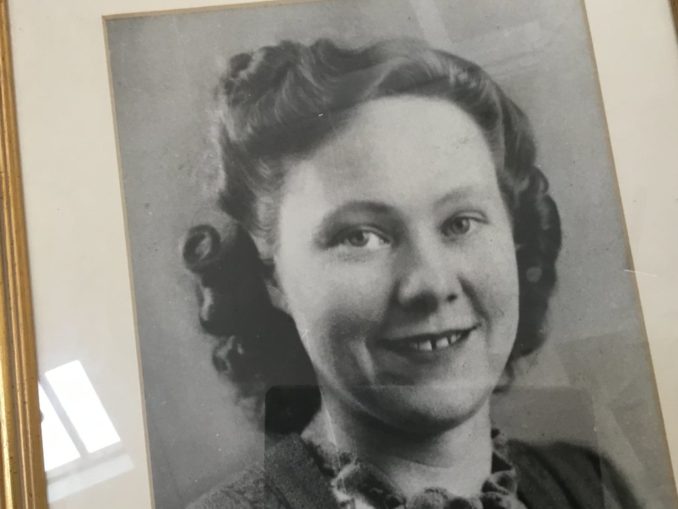
© Mojo, Going Postal 2021
My mother died on 14 February 2002. It still feels like only yesterday I lost her. Very suddenly without any previous illness.
My mum was born in 1919 to a war torn and disabled father and a mother whose family were run ragged through loss of their husbands, sons, brothers. She was born under Bow Bells, at home, in Cheapside. Her family had owned houses in Danbury Street, Camden but as with all families bad decisions, debts and changing societies caused a downturn in wealth. By the time my mum was born the family rented half of the last family house which linked to Camden Passage. It was decided that my mum and her parents should move back to the family at Camden. There she lived her childhood from 4 yrs old running errands, working in Camden market with an Aunt who taught her to sew.
Her childhood was happy but difficult. Her father had been disabled in the Great War. He was one of many who were in charge of the big horse drawn gun carriages. Four horses pushed as hard as the soldiers. Two soldiers per four horses and when the mustard gas rolled across the battle ground they each had to put the gas masks on their horses before they fixed their own. The horses were usually very big farm horses used to heavy work. Most were Shire but as the war rolled on any were used.
My grandfather (Mum’s dad) had to deal with a badly wounded ‘brother’ and four horses before he could protect himself. The gas rolled over them all. My Grandfather and two horses survived. It left him permanently sick and unable to walk far or breathe easily. He died through lack of oxygen because government policy changed regarding the welfare of veterans and his oxygen was taken away. He was 29 years old. Mum was 10 yrs old.
It was decided that mum should go to school rather than work on the market. It was this decision that changed her life. One of the teachers at the school realised how capable she was in art and drawing. She thought mum could gain a scholarship into a trade school for design and pattern making. She put her forward for a scholarship at the Bloomsbury Trade Board. However, mum decided not to present the drawings of houses and music halls she had done at school, but to take her design of a dress and coat she had created for a cousin’s wedding. The Principal of the Trade School Group decided that her creativity was better suited to tailoring. An apprenticeship funded by the big fashion houses.
One of those houses was Norman Hartnell dressmaker to the Royal Family. Of course there was much celebration within the household when mum attained her scholarship/apprenticeship. It didn’t mean she would go on to work for Hartnell but she did have her apprenticeship paid by him.
It took her four years to gain that qualification. In the meantime the Depression had taken its toll and many were still unemployed. As told above, in our family most of the men had been killed or maimed in the Great War. So it was the women who were left to provide for their families. Many women had remained in work rather than marrying after 1918 in order to help other family members put food on the table. Some women, of course, wanted to support themselves and chose to stay single as it was expected that once married they would return to the ‘kitchen sink’. The reality being that most women worked one way or another but the ‘elegant’ jobs of shop assistant or stenographer were only open to single women.
My mother was privileged in that she had a scholarship but it didn’t mean her mother was able to feed the family. My great grandmother was living in the house as well and had been earning a little money by playing the piano in pubs and halls. However, she was getting older and losing her sight. My grandmother was taking in washing and ironing. Mum’s younger sister was helping on the market stall where mum had worked. So each week the family could expect to bring in enough to keep the pot boiling on the stove and a little meat on Sunday. They also got bread free as mum’s contribution to the household by now, was delivering to the big houses in Colebrook Row each morning before going to school. She was given a bike with a large basket to carry the loaves and rolls. She had to collect the money too. The son of the local baker had the hots for mum apparently but thought she spoke too ‘posh’.
So in November 1937 mum achieved her dressmaking and tailoring qualification. All the girls had to create a pattern for a skirt, a blouse and a coat. Then cut and sew those items to pass their final exams. Mum loved hand sewing, as I do, so her blouse had some embroidery on the collar and cuffs. She also decided to sew the zip to her skirt by hand rather than the new way of using a Singer sewing machine. All the girls’ work was then displayed to the sponsors of the scholarships. It was a nerve wracking time because any girl who was not offered a job expected to end up in the large department stores as a sales assistant or alterations seamstress. Jobs that did not pay well, but considered a good solid job for young working class ladies. It was better than the sweat shops of the East End. However, the girls had been given a wonderful opportunity and they didn’t want to let their families down.
Norman Hartnell’s top fitter was visiting the Trade School as he was busy preparing new outfit designs for the 1939 Royal visit to Canada. She took to my mum’s outfits and loved the intricate embroidery on the blouse. She also liked the precision pattern making and details on the pattern rather than just dots and small arrows that were usual. Mum got her dream job. She didn’t however, just get her dream job, she also got taught intricate beadwork patterns and sewing by the Hartnell House. She went on to hand sew all the pearls on the Queen Mother’s beautiful white Canadian dress that showed off the blue sash of the Garter. Her salary was a very handsome 28/- per week. Her family had not known such wealth for many years. She subsequently led the team who made a number of the Queen Mother’s official outfits. She also transferred a number of Hartnell’s designs into patterns for his ready to wear collections. Of course she worked throughout WWII but because she was a proud London Cockney and never failed to tell us all, she did her bit as a firefighter in the Blitz too.
It was just before an air raid she met my father at a roller skating rink after a band concert when they all rushed to the shelters but my mum had to go on duty. My father decided to go with her in case she got hurt…..LOL. He was on leave. He was REME, so another story for another day.
They married when dad returned from Nairobi in 1948. My brother and I were born in 1951.
My mum stopped work when she married. As was still usual then. The reality being that most women stopped full time work but found a little part time work. So mum stopped work with Hartnell. She carried on making dresses from a shed in our council house garden that dad built so that mum could create her own business. She went on to make dresses for two Miss England beauty queens and many outfits for brides and their mothers. Her real love was tailoring which she did until her arthritis kicked in hard during her 70s. She made my first outfit when I started work at 16 yrs old. A beautiful navy blue short sleeved fitted dress with a pink band round the hem. The matching navy blue tailored coat had pink collar and cuffs and pink silk lining. I was so proud of that outfit and had so many compliments that I badgered mum to teach me to sew clothes and not just pretty collars and small household items.
I am thinking a lot about mum recently. We are going through strange times. She was a very proud woman who loved her family and her roots. She worked hard all her life, from age 6 yrs onward. Giving her pennies from the market stall to her mother to help pay for food or indeed coal for the fire in winter. When she earned such a large salary at Hartnell the majority went to help her grandmother’s medical fees and special treats as she grew more frail, as well as paying the rent for their four rooms in number 20. By the time she married her grandmother had died, her mother had fought the government and claimed the army pension she should have had years before when her husband passed. She was able to live without worry until her death in 1996 but she did always take washing in until shortly before her death. And read the tea leaves….. She was born in 1900 so at 96 yrs old and still working belies the rhetoric of today that women are hard done by. My mum worked until her late 70s when her arthritis forced her to stop hand sewing and finishing garments. Work was drying up anyway due to the cheap imports ironically, from the sweatshops abroad. She spent her last few years teaching tailoring to students who wanted to add to their dressmaking skills. Many of those students felt their university and City and Guilds courses were not giving them the edge in a competitive workplace. They wanted something extra. Hand finishing, traditional Haute Couture techniques in order to secure the best jobs. By the time she laid down her tools my parents owned their own house and mum had run a small successful business that developed into a well respected exclusive school to help further students working skills. Not bad for a scrawny, underfed kid from Old London Town.

© Mojo, Going Postal 2021
This is a story of London folk. Ordinary people, living extraordinary lives with the twists and turns of fete. My mum was my role model. I loved her contentedness. Her steely strength when needed. Her generosity to all she came in contact with. Her talent too gave me a real desire to create my own place in this world. She proved to me that we could do anything we wanted as long as we had faith in the future and a willingness to work hard. I miss her terribly.
© Mojo 2021
The Goodnight Vienna Audio file



